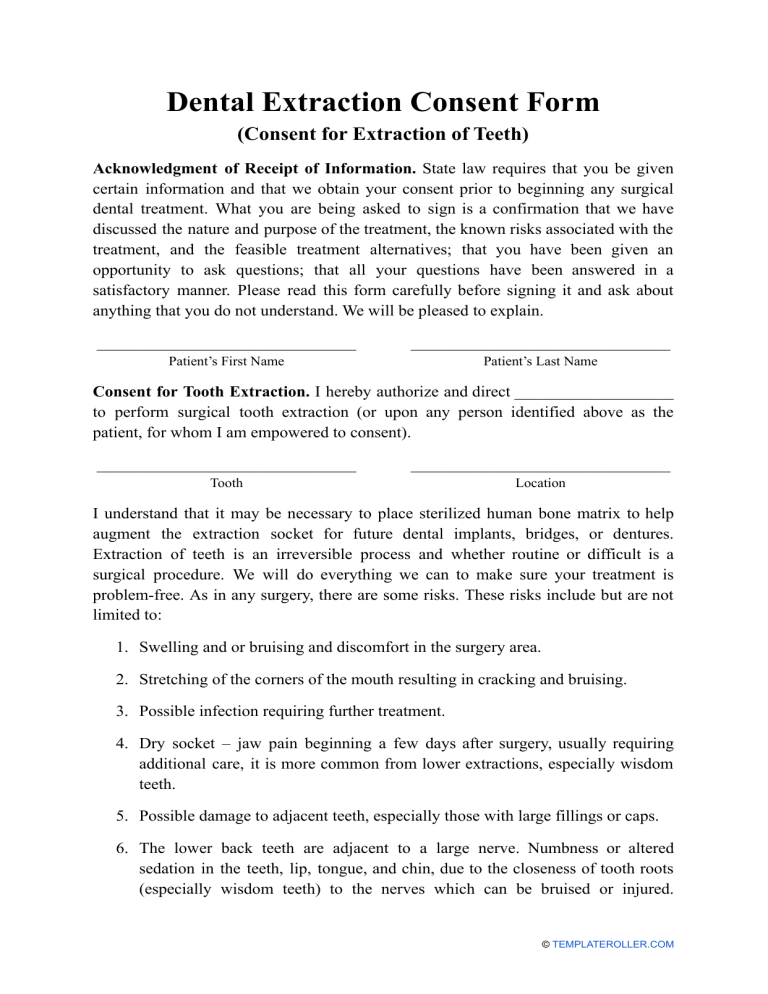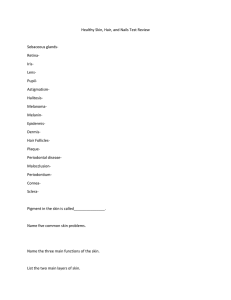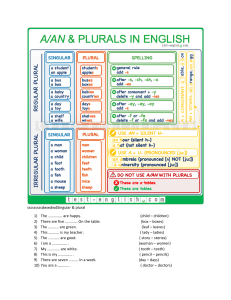
Dental Extraction Consent Form (Consent for Extraction of Teeth) Acknowledgment of Receipt of Information. State law requires that you be given certain information and that we obtain your consent prior to beginning any surgical dental treatment. What you are being asked to sign is a confirmation that we have discussed the nature and purpose of the treatment, the known risks associated with the treatment, and the feasible treatment alternatives; that you have been given an opportunity to ask questions; that all your questions have been answered in a satisfactory manner. Please read this form carefully before signing it and ask about anything that you do not understand. We will be pleased to explain. _______________________________ _______________________________ Patient’s First Name Patient’s Last Name Consent for Tooth Extraction. I hereby authorize and direct ___________________ to perform surgical tooth extraction (or upon any person identified above as the patient, for whom I am empowered to consent). _______________________________ _______________________________ Tooth Location I understand that it may be necessary to place sterilized human bone matrix to help augment the extraction socket for future dental implants, bridges, or dentures. Extraction of teeth is an irreversible process and whether routine or difficult is a surgical procedure. We will do everything we can to make sure your treatment is problem-free. As in any surgery, there are some risks. These risks include but are not limited to: 1. Swelling and or bruising and discomfort in the surgery area. 2. Stretching of the corners of the mouth resulting in cracking and bruising. 3. Possible infection requiring further treatment. 4. Dry socket – jaw pain beginning a few days after surgery, usually requiring additional care, it is more common from lower extractions, especially wisdom teeth. 5. Possible damage to adjacent teeth, especially those with large fillings or caps. 6. The lower back teeth are adjacent to a large nerve. Numbness or altered sedation in the teeth, lip, tongue, and chin, due to the closeness of tooth roots (especially wisdom teeth) to the nerves which can be bruised or injured. © TEMPLATEROLLER.COM Sensation most often returns to normal, but in rare cases, the loss may be permanent. 7. Trismus – limited jaw opening due to inflammation or swelling, most common after wisdom tooth removal. Sometimes it is the result of jaw joint discomfort (TMJ), especially when TMJ disease and symptoms already exist. 8. Bleeding – significant bleeding is not common, but persistent oozing can be expected for several hours. 9. Sharp ridges or bone splinters may form later at the edge of the socket. These may require another surgery to smooth or remove them. 10. Incomplete removal of tooth fragments – to avoid injury to vital structures such as nerves or sinuses, sometimes small root tips may be left in place. Sinus involvement: The roots of upper back teeth are often close to the sinus and sometimes a piece of root can be displaced into the sinus, or an opening may occur into the mouth which may require additional care. 11. The upper back teeth can be very close to the sinus. In rare instances, a communication between the sinus and the extraction socket can occur. In extremely rare circumstances a toot or part of the tooth can be pushed into the sinus. All these situations are fully manageable. 12. Most procedures are routine and serious complications are not expected. Those, which do occur, are most often minor and can be treated. I hereby state that I have read and I fully understand this consent form. I have been given an opportunity to ask any questions I might have had, that those questions have been answered in a satisfactory manner. _______________________________ _______________________________ Date Signature © TEMPLATEROLLER.COM









